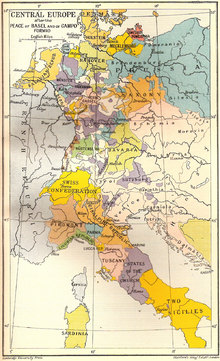Treaty of Campo Formio
This article includes a list of generalreferences,butit lacks sufficient correspondinginline citations.(October 2011) |
| Treaty of Campo Formio between the French Republic and Austria Traité de Campo-Formio entre la République française et l'Autriche | |
|---|---|
 Last page of the public part of the treaty | |
| Signed | 17 October 1797 |
| Location | Campoformido,Republic of Venice |
| Signatories | |
| Depositary | Archives Nationales |
| Language | French |
TheTreaty of Campo Formio(todayCampoformido) was signed on 17 October 1797 (26VendémiaireVI)[1][2]byNapoleon Bonaparteand CountPhilipp von Cobenzlas representatives of theFrench Republicand theAustrian monarchy,respectively.[3][4]The treaty followed thearmistice of Leoben(18 April 1797), which had been forced on the Habsburgs by Napoleon's victoriouscampaign in Italy.It ended theWar of the First Coalitionand leftGreat Britainfighting alone against revolutionary France.
The treaty's public articles concerned only France and Austria and called for aCongress of Rastattto be held to negotiate a final peace for theHoly Roman Empire.In the treaty's secret articles, Austria as the personal state of the Emperor promised to work with France to certain ends at the congress. Among other provisions, the treaty meant the definitive end to the ancientRepublic of Venice,which wasdisbanded and partitionedby the French and the Austrians.
The congress failed to achieve peace, and by early 1799 France and Austria were at war again. The new war, theWar of the Second Coalition,ended with thePeace of Lunéville,a peace for the whole empire, in 1801.
Location[edit]
Campo Formio, now calledCampoformido,is a village west ofUdinein historicalFriuliregion in north-eastern Italy, in the middle between Austrian headquarters in Udine and Bonaparte's residence. The French commander resided atVilla Manin,the country mansion ofLudovico Manin,the lastDoge of Venice,nearCodroipo.The treaty was signed in an old house in the main square of the village, property of Bertrando Del Torre, a local merchant.
On 18 January 1798, Austrian troops entered Venice, and three days later, they held an official reception at the Doge's Palace, where Ludovico Manin was a guest of honour.[5]
Terms[edit]

Beyond the usual clauses of "firm and inviolable peace", the treaty transferred a number of Austrian territories into French hands. Lands ceded included theAustrian Netherlands(most of modernBelgium). Territories of theRepublic of Venicewere divided between the two states: certain islands in theMediterranean,includingCorfuand other Venetian possessions in theIonian Seawere turned over to the French.
The city ofVenicewithTerraferma(Venetian mainland),Venetian Istria,Venetian Dalmatiaand theBay of Kotorregion were turned over to the Habsburg emperor. Austria recognized theCisalpine Republicand the newly createdLigurian Republic,formed ofSavoyard stateandGenoeseterritories, as independent powers.
The Italian states formally ceased to owe fealty to the Holy Roman emperor, ending the formal existence of theKingdom of Italy,which, as a personal holding of the emperor, had existedde jurebut notde factosince at least the 14th century.
The treaty contained secret clauses signed by Napoleon and representatives of the Holy Roman emperor,[6]which divided up certain other territories, and agreed to the extension of the borders of France up to theRhine,theNette,and theRoer.Free French navigation was guaranteed on the Rhine, theMeuseand theMoselle.The French Republic had been expanded into areas that had never before been under French control.
The treaty was composed and signed after five months of negotiations. It was basically what had been agreed earlier at theTreaty of Leobenin April 1797, but the negotiations had been spun out by both parties for a number of reasons. During the negotiating period the French had to crusha royalist coupin September. That was used as a cause for the arrest and deportation of royalist and moderate deputies in theDirectory.
Napoleon's biographer,Felix Markham,wrote "the partition of Venice was not only a moral blot on the peace settlement but left Austria a foothold in Italy, which could only lead to further war." In fact, the Peace of Campo Formio, though it reshaped the map of Europe and marked a major step in Napoleon's fame, was only a respite. One consequence was thePeasants' War,which erupted in theSouthern Netherlandsin 1798 following the French introduction ofconscription.[7]
As a result of the treaty,Gilbert du Motier, marquis de Lafayette,a prisoner from the French Revolution, was released from Austrian captivity.
By passing Venetian possessions in Greece, such as theIonian Islands,toFrench rule,the treaty had an effect on later Greek history neither intended nor expected at the time.
References[edit]
- ^"Treaty of Campo Formio | France-Austria [1797]".
- ^"FRAN_IR_055193 - Online reading room".siv.archives-nationales.culture.gouv.fr.Retrieved2024-04-22.
- ^Jones, p. 512.
- ^Lefebvre, pp. 199–201.
- ^Perocco & Salvadori p1171
- ^Paul Fabianek, Folgen der Säkularisierung für die Klöster im Rheinland – Am Beispiel der Klöster Schwarzenbroich und Kornelimünster, 2012, Verlag BoD,ISBN978-3-8482-1795-3,page 8 (copy of the original page of the treaty's secret clauses with signatures and seals)
- ^Ganse, Alexander."The Flemish Peasants War of 1798".World History at KMLA.Korean Minjok Leadership Academy.Retrieved29 September2014.
Sources[edit]
- Perocco, Guido & Antonio Salvadori (1986).Civiltà di Venezia, Volume 3: l'età moderna.Venezia: Stamperia di Venezia.
- Lefebvre, Georges(1964).The French Revolution, Volume II From 1793–1799.New York: Columbia University Press.ISBN0-231-02519-X.Retrieved2011-01-07.
- Jones, Colin(2002).The Great Nation: France from Louis XV to Napoleon 1715–99.New York: Columbia University Press.ISBN0-231-12882-7.
- Schroeder, Paul W. (1996).The Transformation of European Politics 1763–1848.Oxford University Press.ISBN9780198206545.
External links[edit]
- Traité de Campo-Formio(original document in French)
- Treaty of Campo Formio(extracts in English)
- Background to the Treaty
 Media related toTreaty of Campo Formioat Wikimedia Commons
Media related toTreaty of Campo Formioat Wikimedia Commons
| Preceded by Battle of Neuwied (1797) |
French Revolution: Revolutionary campaigns Treaty of Campo Formio |
Succeeded by French invasion of Switzerland |
- Treaties of Flanders
- Secret treaties
- Modern history of Italy
- 1797 treaties
- Peace treaties of the French Revolutionary Wars
- Treaties involving territorial changes
- Croatia under Habsburg rule
- 1797 in Italy
- 1797 in the Habsburg monarchy
- 1797 in France
- 1797 in the Republic of Venice
- Austria–France relations
- Treaties of the French First Republic
- Treaties of the Habsburg monarchy
- French rule in the Ionian Islands (1797–1799)
- France–Habsburg monarchy relations
- Ligurian Republic
- Cisalpine Republic
- Fall of the Republic of Venice
- 18th-century military history of Italy
- Napoleon
